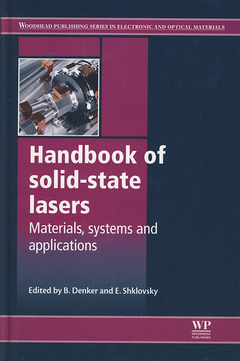Description
Handbook of Solid-State Lasers
Materials, Systems and Applications
Woodhead Publishing Series in Electronic and Optical Materials Series
Coordinators: Denker B, Shklovsky E
Language: English
Subjects for Handbook of Solid-State Lasers:
688 p. · 15.5x23.2 cm · Hardback
Description
/li>Contents
/li>Biography
/li>Comment
/li>
Contributor contact details
Woodhead Publishing Series in Electronic and Optical Materials
Foreword
Preface
Part I: Solid-state laser materials
Chapter 1: Oxide laser crystals doped with rare earth and transition metal ions
Abstract:
1.1 Introduction
1.2 Laser-active ions
1.3 Host lattices
1.4 Laser medium geometry
1.5 Rare earth-doped sesquioxides
1.6 Mode-locked sesquioxide lasers
1.7 Future trends
Chapter 2: Fluoride laser crystals
Abstract:
2.1 Introduction
2.2 Crystal growth, structural, optical and thermo-mechanical properties of the most important fluoride crystals
2.3 Pr3 + doped crystals for RGB video-projection and quantum information experiments
2.4 Yb3+ doped fluorides for ultra-short and high-power laser chains
2.5 Undoped crystals for nonlinear optics and ultra-short pulse lasers
Chapter 3: Oxide laser ceramics
Abstract:
3.1 Introduction
3.2 Ceramics preparation
3.3 Physical properties of oxide laser ceramics
3.4 Solid-state lasers using oxide ceramic elements
3.5 Conclusion
3.6 Acknowledgements
Chapter 4: Fluoride laser ceramics
Abstract:
4.1 Introduction
4.2 Fluoride powders: chemistry problems and relevant technology processes
4.3 Fluoride ceramics as optical medium
4.4 Development of the fluoride laser ceramics synthesis protocol
4.5 Microstructure, spectral luminescence and lasing properties
4.6 CaF2:Yb3 + system
4.7 Prospective compositions for fluoride laser ceramics
4.8 Conclusion
4.9 Acknowledgments
4.10 Note to the reader
Chapter 5: Neodymium, erbium and ytterbium laser glasses
Abstract:
5.1 Introduction
5.2 The history of laser glasses
5.3 Commercial laser glasses
5.4 Modern neodymium and erbium laser glasses
5.5 Ytterbium glasses
5.6 Future trends in glass-based laser materials
Chapter 6: Nonlinear crystals for solid-state lasers
Abstract:
6.1 Introduction
6.2 Second-order frequency conversion
6.3 Nonlinear crystal development
6.4 Nonlinear crystals: current status and future trends
6.5 Sources of further information and advice
Part II: Solid-state laser systems and their applications
Chapter 7: Principles of solid-state lasers
Abstract:
7.1 Introduction
7.2 Amplification of radiation
7.3 Optical amplifiers
7.4 Laser resonators
7.5 Model of laser operation
7.6 Conclusion
Chapter 8: Powering solid-state lasers
Abstract:
8.1 Introduction
8.2 Safety
8.3 Flashlamp pumping
8.4 Laser diode pumping
8.5 Control features
8.6 Conclusion
Chapter 9: Operation regimes for solid-state lasers
Abstract:
9.1 Introduction
9.2 Continuous-wave operation
9.3 Pulsed pumping of solid-state lasers
9.4 Q-switching
9.5 Mode locking
9.6 Chirped-pulse amplification
9.7 Regenerative amplification
Chapter 10: Neodymium-doped yttrium aluminum garnet (Nd:YAG) and neodymium-doped yttrium orthovanadate (Nd:YVO4)
Abstract:
10.1 Introduction
10.2 Oscillators for neodymium lasers
10.3 Power/energy limitations and oscillator scaling concepts
10.4 Power scaling with master oscillator/power amplifier (MOPA) architectures
10.5 Future trends
10.6 Sources of further information and advice
Chapter 11: System sizing issues with diode-pumped quasi-three-level materials
Abstract:
11.1 Introduction
11.2 Ytterbium-doped materials and bulk operating conditions
11.3 Overview of Yb-based systems pump architectures and modes of operation
11.4 YAG–KGW–KYW-based laser systems for nanosecond and sub-picosecond pulse generation
11.5 Conclusion and future trends
Chapter 12: Neodymium doped lithium yttrium fluoride (Nd:YLiF4) lasers
Abstract:
12.1 Introduction
12.2 Pumping methods of Nd:YLF lasers
12.3 Alternative laser transitions
12.4 Future trends
Chapter 13: Erbium (Er) glass lasers
Abstract:
13.1 Introduction
13.2 Flashlamp pumped erbium (Er) glass lasers
13.3 Laser diode (LD) pumped erbium (Er) glass lasers
13.4 Means of Q-switching for erbium (Er) glass lasers
13.5 Applications of erbium (Er) glass lasers
13.6 Crystal lasers emitting at about 1.5 microns: advantages and drawbacks
Chapter 14: Microchip lasers
Abstract:
14.1 Introduction
14.2 Microchip lasers: a broadly applicable concept
14.3 Transverse mode definition
14.4 Spectral properties
14.5 Polarization control
14.6 Pulsed operation
14.7 Nonlinear frequency conversion
14.8 Microchip amplifiers
14.9 Future trends
14.10 Sources of further information and advice
Chapter 15: Fiber lasers
Abstract:
15.1 Introduction and history
15.2 Principle of fiber lasers
15.3 High power continuous wave (CW) fiber lasers
15.4 Pulsed fiber lasers
15.5 Ultrafast fiber lasers
15.6 Continuous wave (CW) and pulsed fiber lasers at alternative wavelengths
15.7 Emerging fiber technologies for fiber lasers
15.8 Conclusion and future trends
Chapter 16: Mid-infrared optical parametric oscillators
Abstract:
16.1 Introduction
16.2 Nonlinear optics and optical parametric devices
16.3 Nonlinear optical materials for the infrared region
16.4 Tuneable single frequency optical parametric oscillators (OPOs) for spectroscopy
16.5 High power and high energy nanosecond pulselength systems
16.6 Ultrashort pulse systems
16.7 Sources of further information and advice
16.8 Future trends
Chapter 17: Raman lasers
Abstract:
17.1 Introduction
17.2 Raman lasers
17.3 Solid-state Raman materials
17.4 Raman generators, amplifiers and lasers
17.5 Crystalline Raman lasers: performance review
17.6 Wavelength-versatile Raman lasers
17.7 Conclusion and future trends
Chapter 18: Cryogenic lasers
Abstract:
18.1 Introduction
18.2 History of cryogenically cooled lasers
18.3 Laser material properties at cryogenic temperatures
18.4 Recent cryogenic laser achievements
18.5 Conclusion and future trends
18.6 Acknowledgment
Chapter 19: Laser induced breakdown spectroscopy (LIBS)
Abstract:
19.1 Introduction to laser induced breakdown spectroscopy (LIBS)
19.2 Types of laser induced breakdown spectroscopy (LIBS) systems and applications
19.3 Solid-state lasers for laser induced breakdown spectroscopy (LIBS)
19.4 Future trends
Chapter 20: Surgical solid-state lasers and their clinical applications
Abstract:
20.1 Introduction
20.2 Laser–tissue interaction
20.3 Clinical applications of solid-state lasers
20.4 Current and future trends in laser surgery
Chapter 21: Solid-state lasers (SSL) in defense programs
Abstract:
21.1 Introduction
21.2 Background
21.3 Properties of laser weapons
21.4 Gas lasers
21.5 Solid-state lasers
21.6 Alternative lasers
21.7 Conclusions and future trends
Chapter 22: Environmental applications of solid-state lasers
Abstract:
22.1 Introduction
22.2 Classification of atmospheric contaminants
22.3 Light scattering as a powerful method for the measurement of atmospheric contamination by aerosols
22.4 Instrumentation based on laser light scattering and absorption for the measurement of aerosols
22.5 Gas monitors based on optical measurement methods using lasers
22.6 Remote sensing using lasers and ground-based and airborne light detection and ranging (LIDAR)
22.7 Conclusion
Index
Eugene Shklovsky is Senior Laser Scientist at Optech Inc, Toronto, Canada.
- Reviews the materials used in solid-state lasers
- Explores the principles of solid-state laser systems and their applications
- Considers defence and environmental applications




